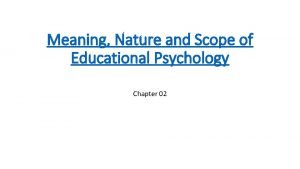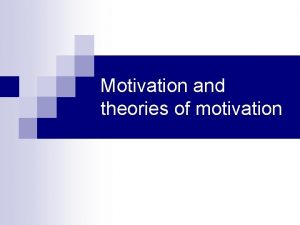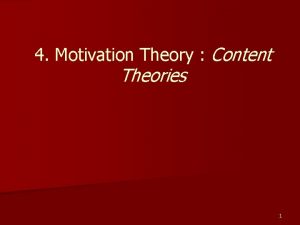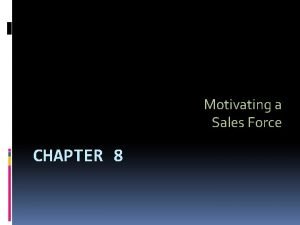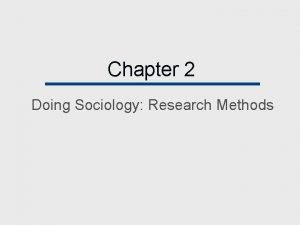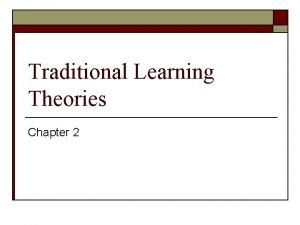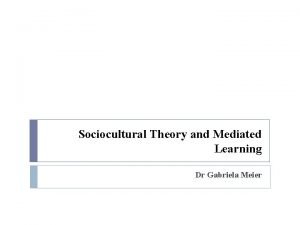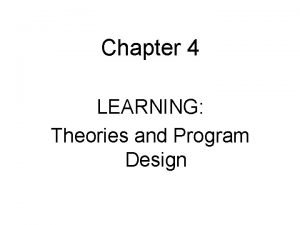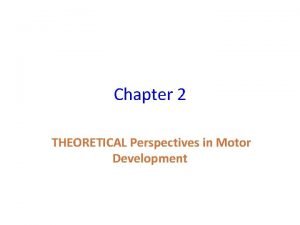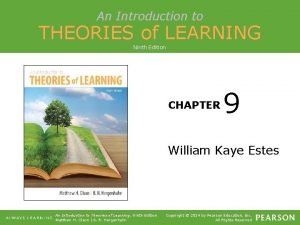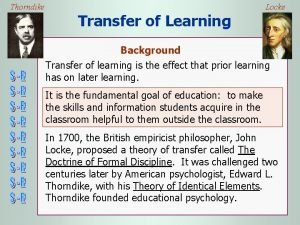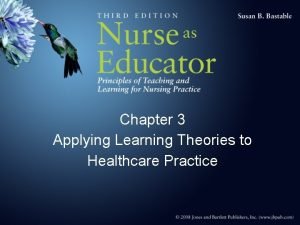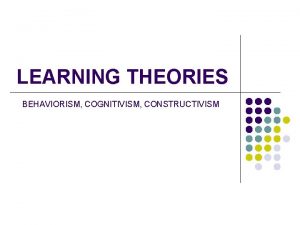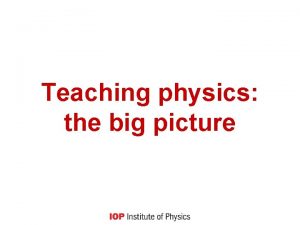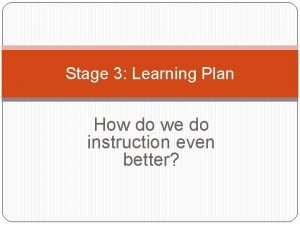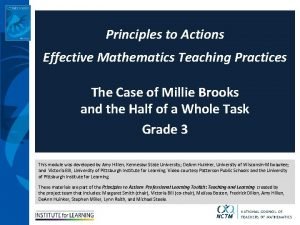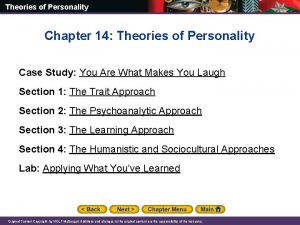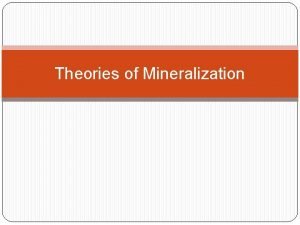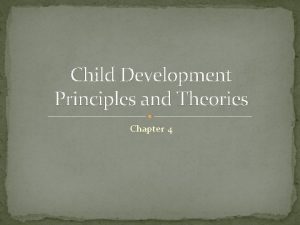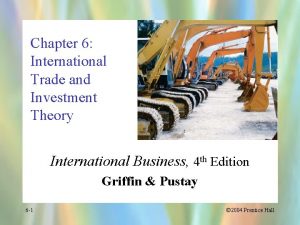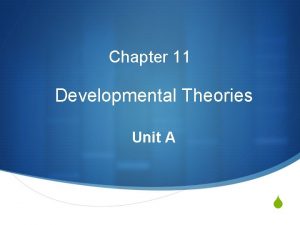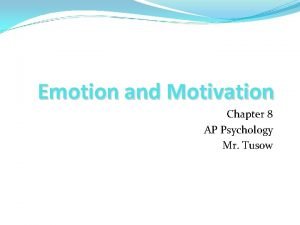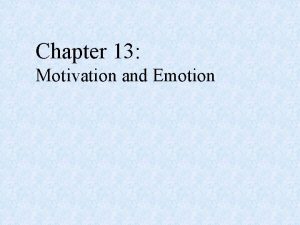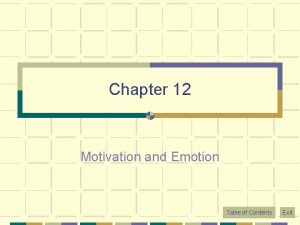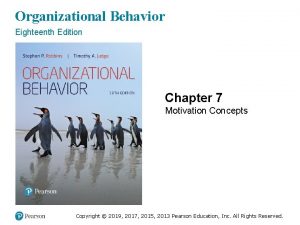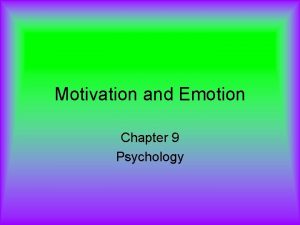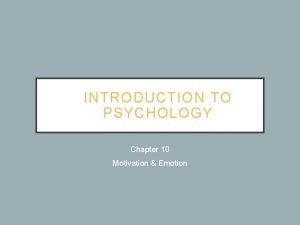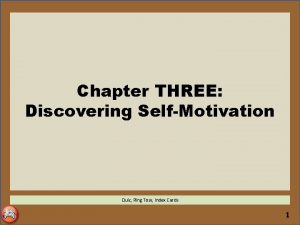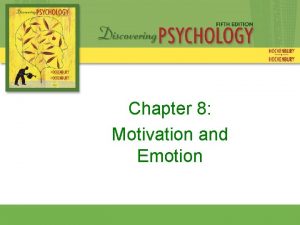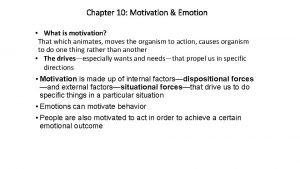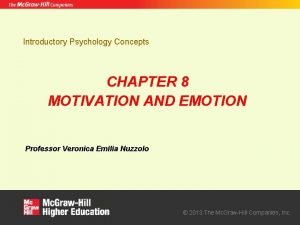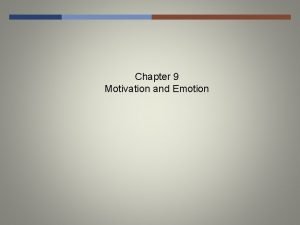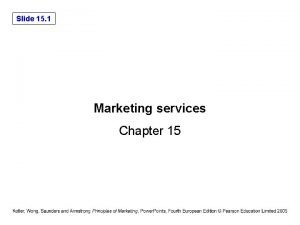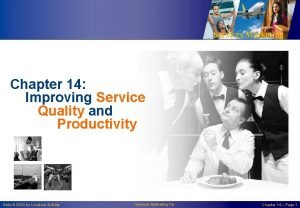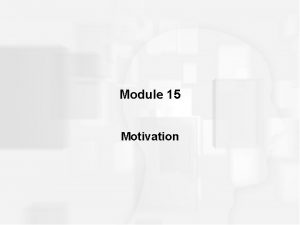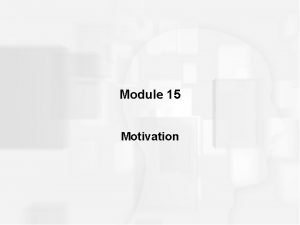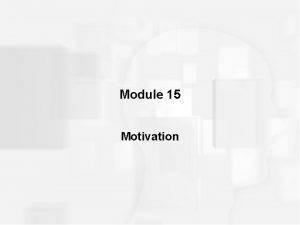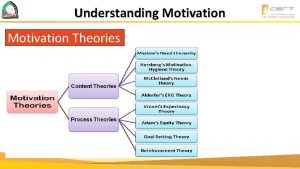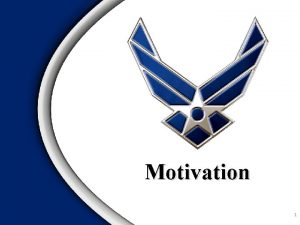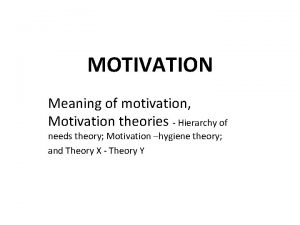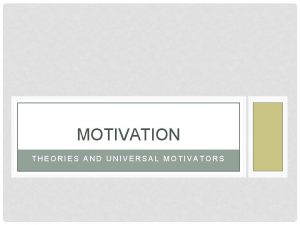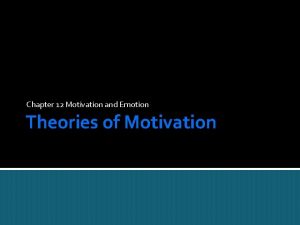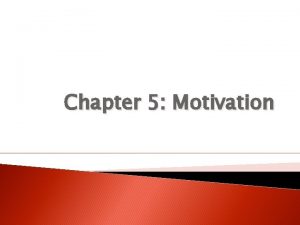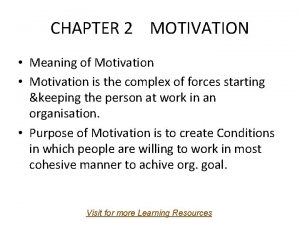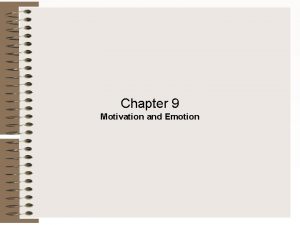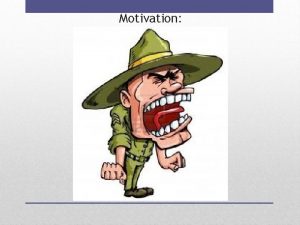Chapter 7 Motivation Need Theories Learning Goals Discuss






























































- Slides: 62

Chapter 7 Motivation: Need Theories

Learning Goals • Discuss the role of needs in behavior in organizations • Describe the major need hierarchy theories of motivation • Appreciate that the importance of particular needs varies from person to person

Learning Goals (Cont. ) • Understand how some needs may be learned • Distinguish between motivator and hygiene factors in a person's environment • Discuss the international and ethical issues in motivation

Chapter Overview • Introduction • Overview of Where We are Headed • Murray's Theory of Human Personality: The Concept of Needs • Maslow's Hierarchy of Needs Theory • E. R. G. Theory

Chapter Overview (Cont. ) • Mc. Clelland's Achievement Motivation Theory • Herzberg's Motivator-Hygiene Theory • International Aspects of the Need theories of Motivation • Ethical Issues and the Need Theories of Motivation

Introduction • Assumptions of motivation Theories – Behavior has a starting point, a direction, and a stopping point – Focus is on voluntary behavior under the control of the person – Behavior is not random. It has purpose and direction

Introduction (Cont. ) Motivation defined Motivation is a psychological process that causes the arousal, direction, and persistence of voluntary actions that are goal directed.

Introduction (Cont. ) Motivation is the psychological process that leads to Choice of behavior that results in Some level of job performance The Motivation-Behavior-Job Performance Sequence

Introduction (Cont. ) • Why know about motivation? – Help you understand your behavior and the behavior of others – Can help a manager build and manage a “system of motivation. ” – Offers conceptual tools for analyzing motivation problems in organizations

Overview of Where We are Headed • Need theories (Chapter 7) – Murray’s Theory of Human Personality – Maslow’s Hierarchy of Needs Theory – E. R. G. Theory – Mc. Clelland’s Achievement Motivation Theory – Herzberg’s Motivator-Hygiene Theory

Overview of Where We are Headed (Cont. ) • Cognitive and behavioral theories (Chapter 8) – Expectancy Theory – Equity Theory – Goal Setting Theory – Behavior Modification

Murray’s Theory of Human Personality • Assumptions – People can adapt to their changing environment – Human behavior is goal directed – Internal and external factors affect behavior – People learn from interactions with their environment – Preconception of future affect behavior now

Murray’s Theory of Human Personality (Cont. ) • Needs – Basic to Murray's theory – Hypothetical concept: helps explain observable differences in behavior – “Invisible link” between a stimulus and a person’s reaction to the stimulus

Murray’s Theory of Human Personality (Cont. ) • Types of needs – Physical needs • Satisfaction of basic physical processes • Need for food, air, water, sex – Psychological needs • Focus on emotional and mental satisfaction • Example: the need for social interaction or to achieve difficult goals

Murray’s Theory of Human Personality (Cont. ) • Some needs in Murray's theory – n Order: organize and systematically arrange objects; be clean, neat, and tidy – n Achievement: attain difficult goals; perform as well as possible – n Recognition: receive credit for actions; to seek honors and recognition The small n in front of the name of each need is the psychologist’s abbreviation for the word need. See text book Table 7. 1

Murray’s Theory of Human Personality (Cont. ) • Some needs in Murray's theory (cont. ) – n Dominance: influence others; affect the direction of a group – n Deference: respect authority; admire a person with authority – n Autonomy: be independent and not be influenced by others – n Affiliation: associate with others, have friends, and join groups

Murray’s Theory of Human Personality (Cont. ) • Characteristics of needs – Latent internal characteristics activated by a stimulus – A person tries to behave in a way that satisfies an activated need Strong need for affiliation: Meet someone you like and start talking to the person

Murray’s Theory of Human Personality (Cont. ) • Characteristics of needs (cont. ) – Needs may show rhythmic patterns over time • Manager could satisfy a Need for Dominance in relationships with subordinates • Same manager is subordinate to someone else in the organization • Engages in behavior directed at the Need for Deference

Murray’s Theory of Human Personality (Cont. ) • Characteristics of needs (Cont. ) – Opposite needs and behavior • Need for Dominance in work role, especially a manager or supervisor • Need for Deference in nonwork (family) role Work Nonwork Need for Dominance Need for Deference

Murray’s Theory of Human Personality (Cont. ) • Characteristics of needs (Cont. ) – Multiple needs and behavior • One need is primary; other need serves the primary • Need for Achievement and Need for Affiliation • Example: joining student organizations. Such activities are important for finding a good job Need for Affiliation serves Need for Achievement

Murray’s Theory of Human Personality (Cont. ) • Implications – Understand own and other’s behavior – Needs vary in importance among people – Directs people’s behavior toward or away from objects – Such knowledge can help managers’ shape a motivation system – Help us understand behavior we see

Maslow’s Hierarchy of Needs Theory • Five groups of basic needs • Healthy adults try to satisfy these needs • So basic that they motivate behavior in many cultures • Chronic frustration of needs can lead to psychopathological results

Maslow’s Hierarchy of Needs Theory (Cont. ) • Physiological needs: basic requirements of the human body; food, water, sleep, sex • Safety needs: desires of a person to be protected from physical and economic harm • Belongingness and love needs (social): desire to give and receive affection; be in the company of others

Maslow’s Hierarchy of Needs Theory (Cont. ) • Esteem needs: self-confidence and sense of self-worth – Esteem from others: valuation of self from other people – Self-esteem: feeling of self-confidence and self -respect • Self-actualization needs: desire for selffulfillment Maslow: “. . . the desire to become more and more what one is, to become everything that one is capable of becoming. ”

Maslow’s Hierarchy of Needs Theory (Cont. ) • Form a need hierarchy based on the “prepotency” of needs • Prepotency: need emerges as a motivator after satisfying a lower-order (more prepotent) need • Hierarchy progression: physiological, safety, belongingness, esteem, selfactualization

Maslow’s Hierarchy of Needs Selfactualization Esteem Belongingness and love Safety See text book Figure 7. 1 Physiological

Maslow’s Hierarchy of Needs Theory (Cont. ) • Need hierarchy – Unsatisfied need is a potential motivator of behavior – Satisfied need is no longer a motivator – Focus on more than one need: promotion leads to more money (esteem and physiological) – Need satisfaction follows the order shown but is flexible – Weak empirical support – Remains a classic interpretation of behavior

E. R. G. Theory • A variation of Maslow's hierarchy of needs • Three groups of needs – Existence needs: physical and material wants – Relatedness needs: desires for interpersonal relationships – Growth needs: desires to be creative and productive; to use one’s skills

E. R. G. Theory (Cont. ) Maslow hierarchy Selfactualization Esteem Belongingness and love E. R. G. Theory Growth needs Relatedness needs Safety Physiological Existence needs Relationship of Maslow’s hierarchy to E. R. G. Theory.

E. R. G. Theory (Cont. ) • Both similar to and different from Maslow's need hierarchy • Satisfied and unsatisfied needs operate in much the same way • Movement upward is the same • Movement downward is new See text book Figure 7. 2

E. R. G. Theory (Cont. ) • Satisfaction-progression: move up the hierarchy as needs are satisfied • Frustration-regression: move down the hierarchy when a need is frustrated • Deficiency cycle: more strongly desire existence needs when they are unsatisfied • Enrichment cycle: more strongly desire growth needs when they are satisfied

Mc. Clelland’s Achievement Motivation Theory • Mc. Clelland colleagues studied the behavioral effects of three needs – Need for Achievement – Need for Power – Need for Affiliation • Emphasized the Need for Achievement, although they investigated all three needs

Mc. Clelland’s Achievement Motivation Theory (Cont. ) • Product of an impressive long-running research program • Controversy over measurement methods • Recent study shows the validity of different measures

Mc. Clelland’s Achievement Motivation Theory (Cont. ) • Strong need for achievement people – Take responsibility for results of behavior – Willing to take calculated risks – Set moderate achievement goals – Prefer to set performance standards for themselves – Prefer nonroutine tasks to routine assignments – Welcome feedback about how well they are doing

Mc. Clelland’s Achievement Motivation Theory (Cont. ) • Acquire the Need for Achievement through socialization to cultural values • Presence of Need for Achievement themes in folklore, mythology, art • Need for Achievement societies had high levels of economic development

Mc. Clelland’s Achievement Motivation Theory (Cont. ) • Strong Need for Power people – Focuses on "controlling the means of influencing the behavior of another person” – Having strong effects on other people – Means of influence: anything available to the person to control the behavior of another – Actively searches for means of influence Example: use superior-subordinate relationship or external rewards to control the behavior of another

Mc. Clelland’s Achievement Motivation Theory (Cont. ) • Two ways of expressing the Need for Power – Dominance, physical aggression, exploitation • View situations from a win-lose perspective • Must win and the other party must lose – Did not feel such power behavior resulted in the type of leadership required by organizations

Mc. Clelland’s Achievement Motivation Theory (Cont. ) • Two ways of expressing the Need for Power (cont. ) – Persuasion and interpersonal influence • Tries to arouse confidence in those he or she wants to influence • Clarifies group’s goals and persuades members to achieve those goals • Emphasizes group members’ ability to reach goals

Mc. Clelland’s Achievement Motivation Theory (Cont. ) • Two ways of expressing the Need for Power (cont. ) • Tries to develop a competence belief in group members • Mc. Clelland felt this type of power behavior characterized effective leaders in organizations

Mc. Clelland’s Achievement Motivation Theory (Cont. ) • Strong Need for Affiliation people – Focuses on "establishing, maintaining, and restoring positive affective relations with others" – Want close, warm interpersonal relationships – Seek the approval of others, especially those about whom they care – Like other people, want other people to like them, and want to be in the company of others

Mc. Clelland’s Achievement Motivation Theory (Cont. ) • Need for achievement and behavior – Money: important to both high and low achievers, but for different reasons • High achiever wants concrete feedback about performance • Making a profit, or receiving a bonus, is a statement about success or failure • Symbol of success and feedback about job performance

Mc. Clelland’s Achievement Motivation Theory (Cont. ) • Need for achievement and behavior (cont. ) • High achiever wants a challenging job and responsibility for work • Want to feel successful at doing something over which they have control

Mc. Clelland’s Achievement Motivation Theory (Cont. ) • Need for achievement and behavior (cont. ) – Low achiever views monetary reward as an end in itself – Get increased performance from low Need for Achievement person by rewarding with money

Mc. Clelland’s Achievement Motivation Theory (Cont. ) • Managers and executives usually have a stronger Need for Achievement than people in other occupations • Evidence points to strong Need for Achievement as an entrepreneur characteristic • Nature of Need for Achievement behavior fits well with such role demands

Mc. Clelland’s Achievement Motivation Theory (Cont. ) • Need for Achievement and Need for Power: some relationships – Strong Need for Achievement person • Task centered • Future oriented • Performs to internal standard of excellence

Mc. Clelland’s Achievement Motivation Theory (Cont. ) • Need for Achievement and Need for Power: some relationships (cont. ) – Strong Need for Power person • • Draws attention Risk taking Present oriented Assesses situations for change potential

Mc. Clelland’s Achievement Motivation Theory (Cont. ) • Need for Achievement and Need for Power: some relationships (cont. ) – Both types of people important for successful organizations – Strong Need for Achievement managers keep an organization going – Strong Need for Power people bring dramatic change and innovation

Herzberg’s Motivator-Hygiene Theory • Early interview research with engineers and accountants – Negative events: mostly involved a person's job context such as company policy and supervision – Positive events: described aspects of the job and feelings of achievement – Salary mentioned about the same number of times in negative and positive reports

Herzberg’s Motivator-Hygiene Theory (Cont. ) • Dissatisfiers: items predominantly found in descriptions of negative events – Could lead to high levels of employee dissatisfaction – Improve the dissatisfiers and reduce dissatisfaction – Not get higher satisfaction

Herzberg’s Motivator-Hygiene Theory (Cont. ) • Satisfiers: items predominantly found in descriptions of positive events – Could lead to high levels of employee satisfaction – Their absence, or a person's failure to experience them, would not produce dissatisfaction

Herzberg’s Motivator-Hygiene Theory (Cont. ) • Two distinct continua: one for satisfaction and one for dissatisfaction • Not a single continuum with dissatisfaction on one end and satisfaction on the other • Herzberg eventually called the satisfiers motivators; the dissatisfiers hygiene factors

Herzberg’s Motivator-Hygiene Theory (Cont. ) • Motivators – Achievement – Recognition – Work itself • Hygiene factors – Company policies and their administration – Quality of supervision – Working conditions

Herzberg’s Motivator-Hygiene Theory (Cont. ) • Dissatisfiers distracted from the motivators • Once the work context is improved, the manager can try to provide the motivators • Use a process called job enrichment • Add more responsibility and autonomy to the job • Creates opportunity for employee to experience the motivators

Herzberg’s Motivator-Hygiene Theory (Cont. ) • Empirical research – Mixed results – Methodological issues – See the text book for details

International Aspects of the Need Theories of Motivation • Concept of needs holds across cultures • People from different cultures may express and satisfy needs differently • Importance of needs in Maslow's need hierarchy – United States: self-actualization – Latin America: security, affiliation – France and Germany: need for security – New Zealand: belongingness and love

International Aspects of the Need Theories of Motivation (Cont. ) • See textbook for results of some large crosscountry studies of Mc. Clelland's Achievement Motivation Theory • Use caution when applying need theories of motivation in different countries • Strong evidence they are culture bound

Ethical Issues and the Need Theories of Motivation • Ethics of directly affecting employee behavior without informed consent • Consider the ethics of actions from the different ethical views in Chapter 3

Ethical Issues and the Need Theories of Motivation (Cont. ) • Utilitarian analysis – Total effects of the manager's efforts – Do they produce a widespread net positive benefit for the organization? • Rights and justice analysis: Employees' rights to know their manager’s intent

Ethical Issues and the Need Theories of Motivation (Cont. ) • Ethical egoism – It is right for a manager to affect behavior because it meets the manager's interests – Interests include unit’s work performance and the manager's career

Ethical Issues and the Need Theories of Motivation (Cont. ) • Ethically required to create need satisfying work experiences? • Existing research does not always show higher performance and satisfaction from work designs aligned with people's needs • Ethical answer rests on the philosophy of each organization and its managers

Ethical Issues and the Need Theories of Motivation (Cont. ) • Should managers consider cultural differences in people’s needs? – Manage according to the needs of people in the host culture, or – Manage as if they were in their home culture?

Ethical Issues and the Need Theories of Motivation (Cont. ) • Utilitarian and rights-based analyses answer "yes" to the first question and "no" to the second – Utilitarian view: managing a multinational operation so it aligns with local people's needs – Rights view: people have the right of congruence with their needs in their work experiences
 Strategic goals tactical goals operational goals
Strategic goals tactical goals operational goals Strategic goals tactical goals operational goals
Strategic goals tactical goals operational goals Amateurs discuss tactics professionals discuss logistics
Amateurs discuss tactics professionals discuss logistics What do you mean by accountancy for lawyers
What do you mean by accountancy for lawyers Meaning and scope of educational psychology
Meaning and scope of educational psychology Early theories of motivation
Early theories of motivation Arousal theory psychology definition
Arousal theory psychology definition Content theories of motivation
Content theories of motivation Incentive theory psychology definition
Incentive theory psychology definition Expectancy theory
Expectancy theory Tujuan pengajaran
Tujuan pengajaran Motivation theory of x and y
Motivation theory of x and y Sales force motivation theories
Sales force motivation theories Ib business motivation theories
Ib business motivation theories Motivation to learn an overview of contemporary theories
Motivation to learn an overview of contemporary theories Applying learning theories to healthcare practice
Applying learning theories to healthcare practice A repetition of, or return to, criminal behavior
A repetition of, or return to, criminal behavior Advantages and disadvantages of sociology
Advantages and disadvantages of sociology General goals and specific goals
General goals and specific goals Examples of generic goals and product-specific goals
Examples of generic goals and product-specific goals Cuadro comparativo e-learning y b-learning
Cuadro comparativo e-learning y b-learning Traditional learning theories
Traditional learning theories Dr gabriela meier
Dr gabriela meier Learning theories and program design
Learning theories and program design Motor learning theories
Motor learning theories An introduction to theories of learning
An introduction to theories of learning Theory of learning
Theory of learning Applying learning theories to healthcare practice quizlet
Applying learning theories to healthcare practice quizlet Psychological factors influencing learning
Psychological factors influencing learning Cognitivism educational theory
Cognitivism educational theory Motivation in ob
Motivation in ob Lnm canvas sheet pdf download
Lnm canvas sheet pdf download Target situation analysis in esp
Target situation analysis in esp Big picture learning goals
Big picture learning goals Amt learning goals
Amt learning goals Establish mathematics goals to focus learning
Establish mathematics goals to focus learning Example of learning objectives
Example of learning objectives Ipc personal learning goals display
Ipc personal learning goals display What does the psychoanalytic approach to personality teach
What does the psychoanalytic approach to personality teach Matrix vesicle theory of mineralization
Matrix vesicle theory of mineralization Child development principles and theories
Child development principles and theories Chapter 6 - theories of international trade and investment
Chapter 6 - theories of international trade and investment Chapter 11 developmental theories
Chapter 11 developmental theories Ap psychology chapter 8 emotion and motivation test
Ap psychology chapter 8 emotion and motivation test Chapter 13 motivation and emotion
Chapter 13 motivation and emotion Chapter 12 motivation and emotion
Chapter 12 motivation and emotion Organizational behavior chapter 7
Organizational behavior chapter 7 Carroll izard 10 basic emotions
Carroll izard 10 basic emotions Paul ekman universal facial expressions
Paul ekman universal facial expressions Readwise token
Readwise token Appraisal psychology meaning
Appraisal psychology meaning Motivation chapter
Motivation chapter Chapter 10 motivation and emotion
Chapter 10 motivation and emotion Chapter 8 motivation and emotion
Chapter 8 motivation and emotion Incentive theory ap psychology
Incentive theory ap psychology Hypothetical dailymotion
Hypothetical dailymotion Chapter 1: the need for cybersecurity
Chapter 1: the need for cybersecurity Mise en place checklist
Mise en place checklist Find market n
Find market n Need a service chapter 15
Need a service chapter 15 Need a service chapter 14
Need a service chapter 14 Russell model affect service marketing
Russell model affect service marketing Need a service chapter 12
Need a service chapter 12




